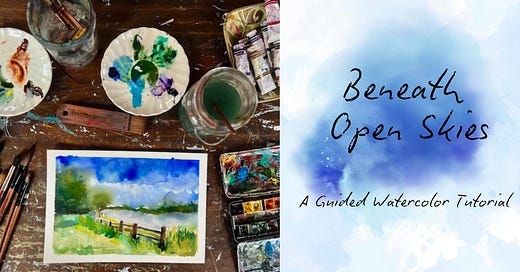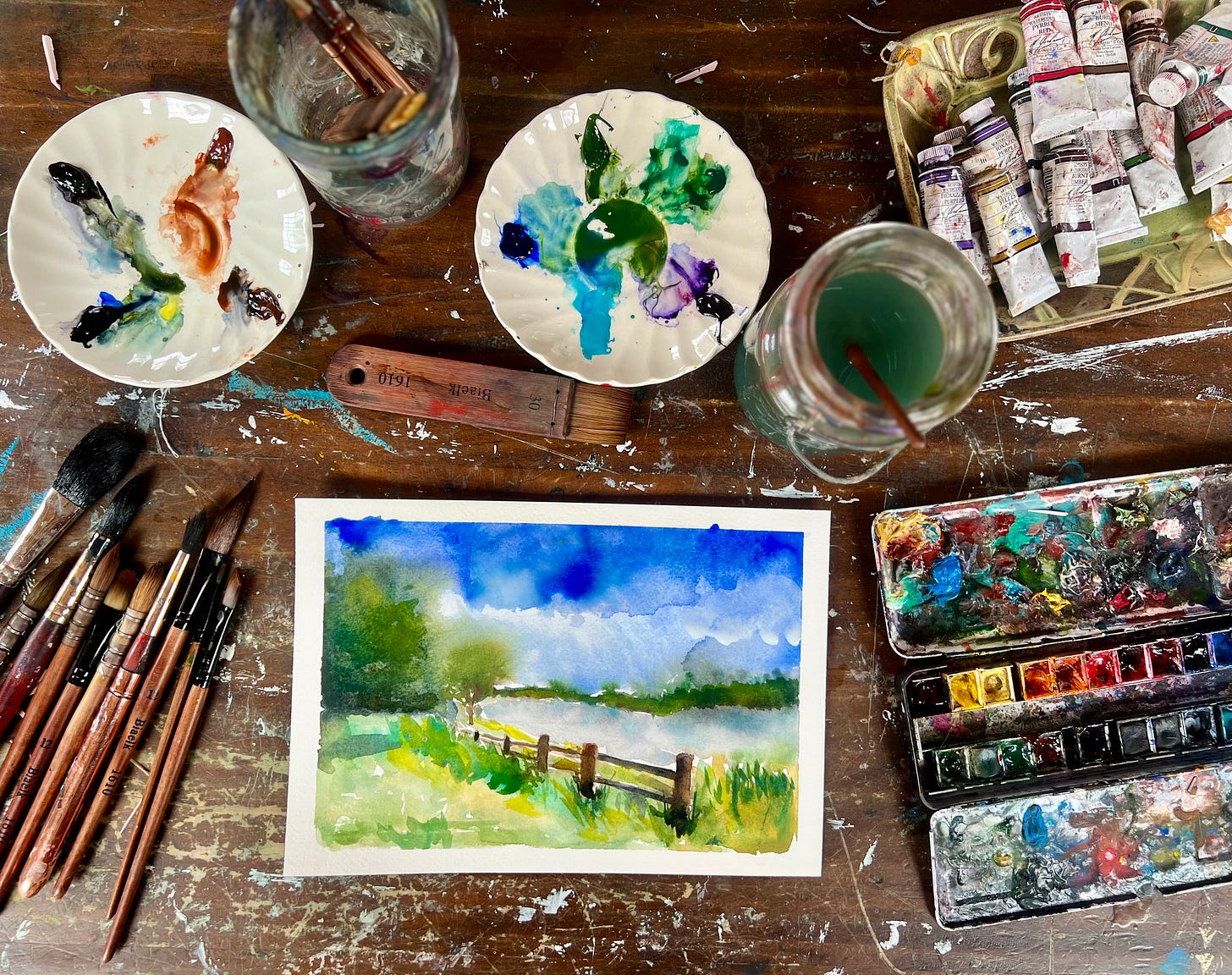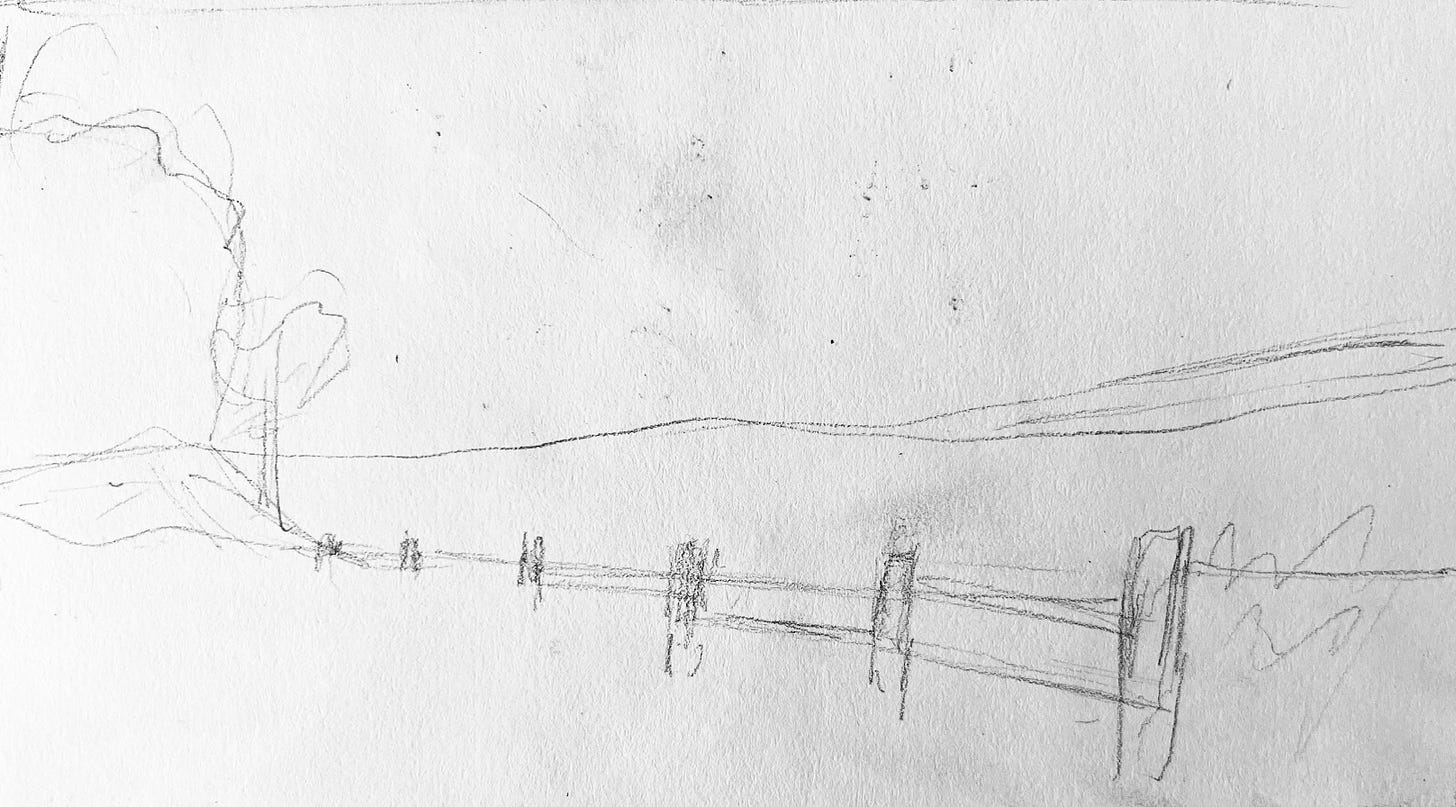Hello Everyone!
Spring’s arrival brings a sense of expansion—the sky stretching wider, the earth waking with fresh greens (not here in Maine *yet* but I’m imagining it!), and the light lingering a little longer. In this tutorial, we’ll capture that sense of openness through a serene landscape with watercolor. Using loose, flowing washes and gentle layering, we’ll paint a tranquil fence line scene, evoking the soft hues and airy atmosphere of early spring.
I’ll guide you through the techniques step by step, from blending a cloud-streaked sky to adding depth with textured foliage and a weathered wooden fence. Whether you’re new to watercolor or refining your skills, this exercise offers space to experiment with color, light, and atmospheric effects.
Along the way, you’ll find journal prompts to deepen your creative reflection—inviting you to explore the story behind the scene and the feelings it evokes.
Gather your supplies, take a breath, and let’s step into this landscape together.
**
Start with a light pencil sketch.
©️John Lutz 2024
Inspiration from
Penobscot River. Medway, Maine.***
Materials Needed:
• Watercolor paper (cold press for texture)
• Watercolor paints: ultramarine blue, cobalt blue, sap green, yellow ochre, burnt sienna, and payne’s gray
• Brushes: round (size 10-12), flat (size 6-8), and a detail brush
• Water, palette, and paper towel
• Masking tape (optional, for clean edges)
Step 1: Sketch the Composition
• Lightly sketch the landscape outline with a pencil.
• Include the horizon line, the shape of the fence, and basic outlines of the trees and grass patches.
• Keep the sketch loose and minimal, focusing on major shapes rather than fine details.
Step 2: Create the Sky with Wet-on-Wet
• Wet the entire sky area with clean water.
• While the paper is still damp, apply ultramarine blue at the top, letting it flow down naturally.
• Add cobalt blue toward the center for variation.
• Leave some white space for clouds by lifting paint with a tissue or dry brush.
• Add a soft touch of gray (a mix of blue and burnt sienna) to form subtle cloud shadows.
Step 3: Establish the Distant Horizon
• While the sky is drying, paint the distant tree line.
• Use a mix of sap green and payne’s gray for a muted, atmospheric tone.
• Keep the edges soft by blending with a damp brush, creating a sense of distance.
• Let the horizon dry before moving to the midground.
Step 4: Paint the Field and Fence
• For the grass, use a mix of yellow ochre and sap green, applying loose, sweeping strokes.
• Vary the greens by adding touches of blue or yellow for depth and variation.
• Paint the fence posts with burnt sienna and a hint of payne’s gray for shading.
• For the fence rails, use a lighter touch with gray tones, leaving some white highlights for dimension.
• Add shadows along the grass and under the fence to anchor it into the scene.
Step 5: Add Depth and Detail
• Use darker green tones to suggest bushes and foliage near the trees.
• Soften the edges with a damp brush to create a sense of softness and distance.
• Add small flicks of paint with a fine brush to suggest wild grasses.
• Refine the fence with subtle details like knots or highlights for a weathered look.
Step 6: Finishing Touches
• Enhance the contrast by darkening the tree area slightly with a mix of sap green and payne’s gray.
• Use a dry brush technique to add texture to the grass in the foreground.
• Step back and assess the painting, making any final adjustments to balance the colors and depth.
***
As you step back from your painting, take a moment to admire the sense of place you’ve created—the stretch of sky, the gentle curve of the fence, and the soft dance of spring grasses. Whether your brushstrokes were bold or delicate, each one captures a fleeting moment of light and landscape, uniquely your own.
Watercolor has a way of teaching us to embrace fluidity—the beauty of softened edges, unexpected blends, and gentle imperfections. Let this piece be a reminder to welcome the organic nature of both art and spring itself: ever-changing, wild, and full of possibility.
If you found yourself inspired, I encourage you to revisit this scene in different ways—try it at sunrise or dusk, with warmer or cooler tones, or let your imagination lead you beyond the fence.
Feel free to share your work in the comments—I’d love to see how you brought this spring landscape to life. Until next time, may your creativity continue to bloom with the season.
Head down the page for journal prompts!
***
The light in me honors the light in you. Thank you for being a part of this creative work. I appreciate your restacks, hearts and comments as it all helps to push our collective, creative energy out into the world!
Please check out my newsletter, Visual Journey 48: Mud, Snow, Rivers and Green for more art, books, music, meditation and inspiration!
XXX Char
***
If you are looking for a more technical tutorial to build your skills, please see my previous tutorial:
Watercolor Essentials: 12 Techniques for Beginners & Beyond
Welcome to this week’s watercolor tutorial, where we’ll explore 12 foundational techniques that will expand your creative toolkit. These methods will help you develop fluidity, depth, and expression in your paintings. Each technique offers unique possibilities for creating texture, blending, and form.
***
Spring-Inspired Prompts Reflecting the Painting
1. The Fence as a Threshold:
Stand at the edge of this fence in your mind’s eye. What are you leaving behind on one side, and what are you stepping into on the other? Write about a threshold moment in your life.
2. The Colors of Spring:
The painting captures the mingling of earth and sky—lush greens, bright yellows, and expansive blues. Describe a place where you’ve witnessed the colors of spring come alive. How did they make you feel?
3. Wind on the Meadow:
Imagine the wind moving through this landscape. What does it carry? The scent of wildflowers, the sound of a distant river, or perhaps a memory? Let the wind guide your words.
4. The Fence’s Story:
This fence, weathered and worn, has stood through many seasons. Write from the fence’s perspective—what has it seen? Who or what has passed by or leaned against it?
5. Reflections of the Sky:
The water in the distance mirrors the sky, holding its colors. Reflect on a time when you saw yourself more clearly through a reflection—whether in nature, another person, or a life experience.
6. The Stillness and the Movement:
The painting captures both the stillness of the fence and the movement of the sky and grass. Write about a moment when you felt both rooted and free, still yet moving.
7. A Path Beyond the Fence:
If you could step over the fence and wander into this scene, where would you go? Let your imagination take you into the distant horizon—describe what you find.


















Share this post